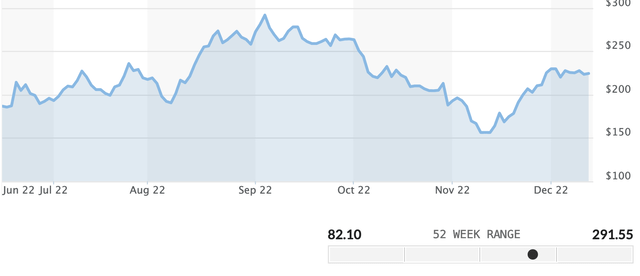Lukas Bischoff/iStock via Getty Images
In a recent article, I looked at Thungela Resources Limited (OTCPK:TNGRF, TGA.L, TGA.JO), a producer and exporter of thermal coal with operations in South Africa. I mentioned that the company was undervalued given its free cash flow generation, despite an extremely challenging operating environment and declining coal prices. The reader is invited to consult the above-mentioned article for an introduction to the company and its valuation. Here, I will content myself with discussing some recent developments that shed some light on exactly how things are going.
At the time, I rated Thungela a hold, citing concerns over production volumes as the reason preventing me from giving it a buy rating. It appears that my concerns were on point. The company has recently disclosed its outlook for the full year’s results. Overall, it’s a mixed bag. Because of logistics challenges, the company has been forced to lower again its guidance for the year. However, the risk/reward profile remains unmatched, and the outlook for thermal coal looks a little brighter at the moment. Considering the huge margin of safety, I believe a buy rating is warranted.
The bad
Operational challenges confronting Thungela include reduced performance along the Transnet railway line, illegal mining activities, and rising costs.
Transnet is still a problem
Transnet performance has deteriorated over the second half of the year, from an annualized average run rate of 53.3Mt in H1 2022, down to 49.0Mt in H2 2022. For comparison, it stood at 73.0Mt in 2018, 71.1Mt in 2019, 70.1 Mt in 2020, and 58.1Mt in 2021. The declining trend has a long history.
This is a significant problem, since it constrains Thungela’s export volumes, leading to a buildup in inventory. It is estimated that about 600kt of exportable production have been lost over 2022 as a result: not a small amount, considering that it equals approximately 5% of the total annual production.
It is likely that the situation is going to partially normalize going forward. Transnet has just had to deal with some really unique circumstances, including a 12-day strike in October, as well as a serious derailment in early November, completely blocking the coal corridor for 10 days. Both crises have now sorted themselves out. There are also some encouraging signs that Transnet is turning the tables in its fight against copper thieves: after a series of more than 1500 arrests, copper thefts have decreased by 30%. Finally, Thungela is doing all the right things in order to mitigate the impact of Transnet underperformance. It has prioritized higher-grade products in its mix, as well as created additional stockpile capacity by resorting to trucks to transport coal between operations.
Nonetheless, the damage has already been done. Some production had to be cut, and the buildup in inventory is significant. First, looking at production, guidance has been lowered again. It stood at 14-15Mt at the beginning of the year. It was then lowered to 13-13.6Mt in August. Now, it is expected to come in at 12.8Mt for the full year. This is 15% below 2021 production of 15.0Mt. Turning to sales, the inventory build is expected to be around 900kt. Total sales should therefore be around 11.9Mt. This is again 14% less than in 2021. The silver lining, of course, is that realized prices have doubled compared to last year.
Illegal mining is an extra source of risk
Illegal mining is a big problem in South Africa. Apart for subtracting resources, illegal mining can create major liabilities for coal producers like Thungela. For instance, back in April, illegal operations at the company’s Khwezela site were publicly exposed after causing a major acid water spill. Thungela was initially blamed for the spill, later proving, however, the real source of the damage, and winning interdicts from a South African court to stop the illegal operations.
To mitigate the risk of future accidents, the company has now declared its intention to close part of the complex. This has led to a R1.1 billion income statement charge in 2022 to cover the closure costs. The charge is higher than initially expected by the company, to account for the surface disturbance caused by the illegal miners.
Costs are still rising
Costs are creeping up. For FY 2021, the FOB cost per export tonne (excluding royalties) was R785. The guidance for FY 2022, revised in August, was for R885 to R915 per tonne. The estimate for FY 2022 is now for R955, marginally above the upper end of the guided range.
The increase in costs can be connected with the logistics disruptions, a non-cash charge of R85 per tonne based on revised environmental provisions, and inflationary pressures (especially for explosives and fuel).
The good
The two main positives are that the final dividend for FY 2022 will be a record one (in line with the interim dividend), and that the thermal coal market remains strong.
Record final dividend incoming
Thungela is swimming in cash. Realized export prices are up more than 100% compared to one year ago (from $124.11/tonne for FY 2021, to $276.57/tonne YTD). Despite rising costs and reduced volumes, cash flow generation is stronger than ever. As of the end of November, the company had no debt and a cash position of R19.8 billion. For comparison, its total market capitalization is around R38 billion.
Since December is expected to be cash flow neutral, because of Transnet delays, we can estimate the final dividend quite easily. First, it should be considered that the company still owes R4 billion in royalties and taxes. An additional R1 billion will be set aside in a self-insurance scheme that the company is starting in December to cover future liabilities. Finally, around R6 billion represents the (maximum) cash cushion that the company has declared in the past to be committed to maintaining under all circumstances. So, the difference, or around R8.8 billion, could be distributed to shareholders. This is therefore my estimate for the final dividend, to be confirmed after the presentation of the annual results in March 2023.
It should be noted that Thungela has already paid out R8.2 billion in H1 2022 as an interim dividend. Based on the current market cap, the TTM dividend yield would be around 45%. This gets down to 38%, when taking into account the withholding tax. Such numbers are so attractive as to be almost unbelievable.
Thermal coal prices have recovered
After a precipitous decline, it now looks like coal prices have firmed up and recovered a bit. In the short-to-medium term, I expect prices to remain strong, especially in light of several bullish macroeconomic factors.
First, compared to my previous article, it now appears that China is seriously on the path to reopening. In addition, thermal coal demand from European countries continues to increase, in an effort to replace lost gas supplies following the Russian invasion of Ukraine. Stocks are high in many countries, but will need to be replenished after the winter season. Finally, the Russian coal industry continues to be plagued by infrastructure problems. For now, Russian coal exports have been successfully rerouted to Asia, and China in particular, after sanctions imposed by the European Union. However, despite exports being at an almost decade-high, Russian supply still cannot keep up with demand. The situation is expected to get worse over the winter, because of an increase in both domestic and Chinese demand.
Coal (API4) FOB Richards Bay (marketwatch.com)
Conclusion
Despite a challenging environment, Thungela is going to post record financial results. Earnings are going to more than double compared with last year. The company is going to pay an incredible R17 billion in dividends, assuming my estimate of R8.8 billion for the final dividend is correct. At current coal prices, the company is just insanely profitable.
Despite global recessionary risks and the unique risks related to South Africa, I continue to see Thungela as an asymmetric risk-reward situation, where the downside is protected by its dividend returns. Barring a societal collapse in South Africa, the company should be able to pay out its entire market capitalization in around 3 years as dividends. For all these reasons, I upgrade my rating to a buy.


Be the first to comment